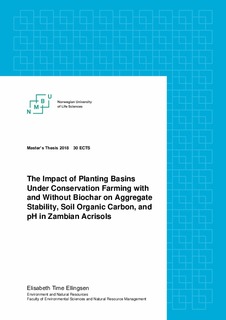| dc.description.abstract | Conservation Farming (CF) in Sub-Saharan Africa (SSA), including reduced tillage, return of crop residue, and crop rotation, has been found to increase maize yields in rain-fed agriculture. In combination with the application of biochar (BC), crop productivity may be further enhanced. Although increased yields have been attributed to improved soil physical and chemical properties, the number of studies supporting this claim are few, especially in Africa where adoption is relatively recent, and where mechanistic understanding of the underlying process and the long-term effects are limited. This study addresses the impact of CF with and without BC on soil properties such as soil organic carbon (SOC), pH, and aggregate stability. This is done by using two separate research fields in Mkushi, Zambia on Acrisols. One focuses on three years of different CF techniques, where CF, CF with and without residue retention, and CF with BC are compared to conventional practises (farm trials). A second site focuses on BC dosage and size of BC particles (BC trials).
In both trials, soil properties including the aggregate stability, pH, soil organic carbon (SOC), total nitrogen (N), and hot water extractable carbon (HWEC) a proxy for labile carbon were, used to interpret soil quality differences between treatments, and their changes over time. Results showed significant improvement of aggregate stability in CF planting basins relative to conventional plots. The positive effect of CF basins was also found for SOC, total N, and HWEC, but not for pH, highlighting the importance of planting basins as an aspect of CF. The labile fraction increased significantly in CF plots compared to conventional, but the SOC content did not. Comparing these finding from early 2018 to those from the start of the experiment in late 2015 highlight minimal changes in total carbon (C), organic C, and total N. However, a distinct decrease in pH was found, probably in response the gradual loss of lime after its application in 2014.
Conservation farming in combination with BC did not improve aggregation, but did significantly increase SOC. However, HWEC did not increase with BC but rather decreased. indicating BC amendment does not increase the labile carbon fraction, and might actually supress it, which can negatively impact soil properties such as nutrient cycling.
A study by Obia et al. (2016) found significant results linking increased BC with improved aggregate stability one and two years after BC application. This conclusion was not confirmed by this study which found no correlation of increased BC dose or size with aggregate stability. However, HWEC correlated significantly to aggregate stability. Indicating HWEC is a major driver of aggregation, whilst BC is not. Thus, the labile C associated with fresh BC should be further researched to determine if the increase in aggregate stability due to BC is actually caused by HWEC, which is high in fresh BC and reduces over time. | nb_NO |

